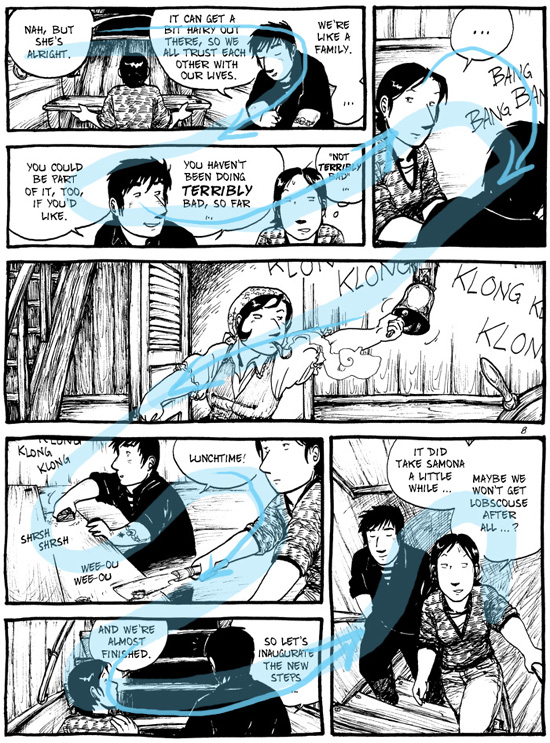Leading the reading
I have no formal education in arts or drawing comics, and a lot of my comics making happens unconsciously. Things I do are good if it just “feels right” or “makes sense” and bad if it “feels wrong”. Sometimes it can take a day or even a week until I find a solution to why something wasn’t working. At such times, I wish I knew more about the theory of making comics, so that I could know exactly why something isn’t working …
One thing I’ve started to pay attention to is how to lead the reader’s eyes across the page.
I started to notice how I do this during the editorial process of my Swedish Comic Sin anthology contribution. The books are made through collective self-publishing, and before the book is put together, everybody can critique each others’ comics and offer advice on what doesn’t work and how something could be better. Several of my fellow artists had problems with my frequent use of this type of layout:

It’s very common in Japanese comics – that’s where I picked it up – and I like to use it because it allows for variety in the layouts. However, there are great risks of a culture clash when Europeans read this type of layout!
In Japanese comics, the reading order is strictly set as demonstrated above, and I can’t remember ever having seen the rules being broken. But in the rare cases when European comics use it, there are no fixed rules for the reading order, so artists often use arrows to point out the (to me often ‘illogical’) reading order. So when European readers are confronted with it and have no arrows to help them, they can get confused.
Now, I could scoff at them for being illogical and uneducated … Or I could compose my panels in such a way that there is no confusion regarding the reading order.
The page most people had a problem with was one where I’d sketched one crucial panel wrong, but didn’t bother fixing it before I sent out the sketches to the editorial collective:
Blue arrows: geometry (shapes, perspective etc.)
Red arrows: faces (and to some degree body language) of characters
Green arrows: speech bubbles and captions

This is how I fixed it in the final version:

I composed panel 5 in a radical “<” shape, picking up the lines from panel 4 and redirecting them towards panel 6.
If I did it today I may even have changed the cabinet on the wall in panel 4, since it has unnecessarily confusing horizontal lines that point towards panel 6 …
I’m not exactly a master of this trade, and I have a lot of room for improvement. But for everyone’s education I will post some more examples behind the cut, from my comic Driftwood!
Here is a kind of tricky one:

In panel 1 there’s a very strong line up towards panel 2 in the painted pattern on the railing, and the speech bubbles in panel 2 pick it up. The speech bubbles in panel 3 stay away from panel 1 to avoid tempting the reader’s eyes.
In panel 4, the composition curves back to the left, towards panel 5, where Eva (being the main point of interest in the panel) picks it up and redirects it across the faces of Willie and Samona towards the lower half of panel 6, where the cup and plates and Aeron’s arm pick it up.
It’s actually a big “NOOO-NOOOO” to place speech bubbles in the middle of a panel in between characters like I did in the last panel. But I really didn’t want to draw all the stuff on their dinner table. V^(oo)^;V

Speech bubbles are reliable to use for directing the reader’s eyes, because they have to be read. But a successful layout uses all the means possible.
Besides, you don’t always get speech bubbles, or even much character action in the pages, so sometimes geometry will have to do:

Here are some pages with panels that are actually read from right to left, not left to right:

Samona’s arms lead your eyes from panel 3 to panel 5.

The shapes through panel 4 and 5 are almost a bit too obvious … V^(oo)^;V But they contribute to the tense atmosphere so it’s okay in this scene.
Speech bubbles can be used in a totally obvious way without it being annoying. But geometry should not be used in a too obvious way, or it can look stupid.
In panel 6, Jan looks to the lower left (at Willie), leading us to the first speech bubble in panel 7.

That hallway is really quite practical in these matters!
More examples with the infamous three-panel-confusion layout:

The speech bubble in panel 1 is not at the right edge of the panel, and the lines implied by Willie’s arm in panel 1 and the sofa in panel 2 direct the reader’s eyes in the correct order.

Arrr, two three-panel-confusion layouts in the same page!
In panel 1, the speech bubble is stuck at the right edge of the panel, but all the lines in the wall point to the lower left, towards panel 2. Panel 3 is composed to pick up the flow from panel 2.
In panel 5, all the interesting stuff happens in the center/upper right part of the panel, and the speech bubble is right next to the first speech bubble in panel 6.
* * *













Very interesting! I am also not educated in art or comics (and I mostly go with my gut feeling…and breaking some rules probably!), so it’s interesting to read something like this! I’ll probably have some of your notes in mind next time I draw a storyboard 🙂